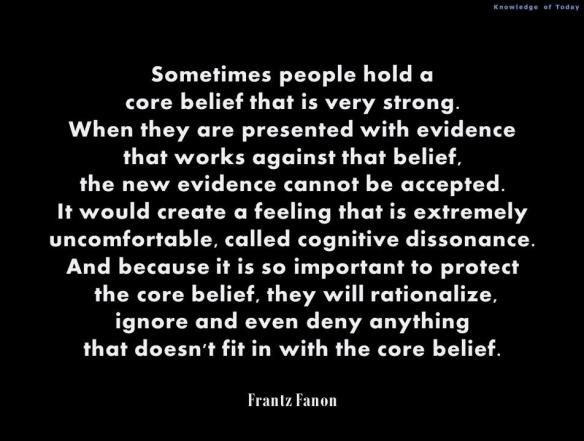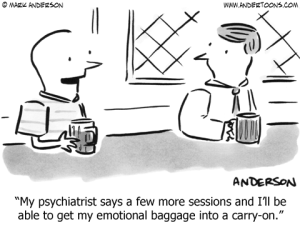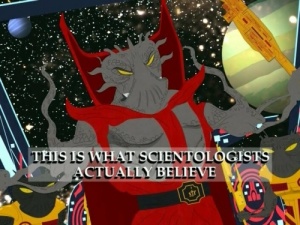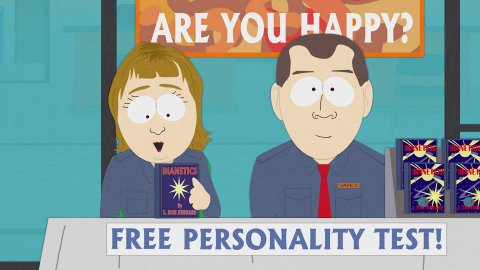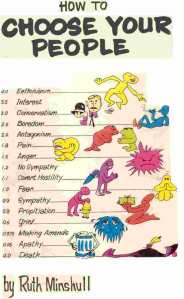
Much has been written about Trump’s toxic psychology, specifically his malignant narcissism. In spite of The Goldwater Rule (an agreement between mental health professionals to never diagnose someone they have not evaluated), so egregious is 45’s bad behavior that thousands of mental health professionals are breaking their own rule and speculating that he does indeed suffer from both Narcissistic Personality Disorder and Psychopathy/Antisocial Personality Disorder (the non-clinical term is “malignant narcissism” when both disorders appear together).
But the problem isn’t limited to Trump. Our “president” (I’m sorry, but I refuse to refer to him as president without adding scare quotes for irony) has surrounded himself with a cabinet full of people as entitled-acting and seemingly lacking in human empathy and devoid of conscience as he is. If they are not sociopathic themselves, they are enabling cowards who keep making excuses for Trump’s horrible behavior and the toxic, abusive things he says. Some seem like programmed robots with no minds of their own, and others actually seem terrified to ever criticize or disobey him.
As for Trump’s pathologically loyal supporters, they really do seem unreachable. No amount of logic, facts, reason, or even appealing emotionally to their “better angels” seem to move them. Like Manson’s young followers who continued to defend Manson’s evil behavior and insane beliefs even to the point where they were willing to murder on his behalf, to his supporters, Trump really could “shoot someone on 5th Avenue” and they would not budge from his side. When presented with facts — even outright proof that their views are wrong — I’ve noticed a tendency for Trump supporters to double down on their pro-Trump beliefs (for example, if science has found that climate change is real, they will tell you that scientists are liars or are misinformed). Much more so than his opponents, Trump supporters seem to resort to personal attacks or angry outbursts, and, when that fails, they will cut you off from further discussion, even blocking you on social media so they don’t have to engage with you further or have their views challenged.
There’s two other situations in which you see this unholy trinity of egotistic authoritarian leader, sociopathic or sycophantic lackeys and enablers, and followers who seem to have no ability to think or act for themselves: in religious cults and in political dictatorships. Trumpism resembles a cult, and in fact it is one. Trump uses the same Machiavellian mind control tactics on his followers and those who carry out his bidding that cult leaders and dictators do.
I do believe we are being tested, and Trump is the logical conclusion of where we’ve been headed since at least the 1970s. His election signals that we have reached rock bottom and are being forced to be accountable — or self-destruct. If we are being tested, then it follows there is a solution, but it’s imperative that we do not allow ourselves to ever normalize what is happening or become so beaten down emotionally, mentally, and spiritually that we feel like there’s nothing we can do and succumb to the abuse — and yes, it is abuse.
The first step in fighting encroaching totalitarianism (let’s not mince words here because that’s exactly what this administration wants to install in place of democracy) is knowing the nature of the beast that threatens us, but to do that, we need to name it.
This is narcissistic abuse. It’s just as incapacitating, soul-destroying, creativity crushing, sickness-engendering, trauma-inducing, and crazy-making as the kind wrought on us by malignantly narcissistic parents, teachers, “friends,” relatives, lovers, and spouses.
But it’s a lot worse than that. It’s worse because it’s narcissistic abuse on a massive, nationwide, possibly worldwide scale. Unlike a toxic family or workplace or marriage, it’s a lot harder to go No Contact when the leader of your country is an abuser. In fact, going No Contact may not even be possible, should WWIII, enslavement, or internment in modern day concentration camps come to pass. This is not hyperbole or conspiracy theory: if things are allowed to continue the way they have been going since January, a high-tech feudalism, modern day replay of Nazi Germany, or even a Christian Taliban with Old Testament law replacing the Constitution will be our new reality.
Because what we are enduring is narcissistic abuse writ large, the same terminology and lingo used by narcissistic abuse survivors to refer to abusive parents, coworkers, lovers, friends, bosses and spouses certainly applies here as well.
So I’m going to present some of these narcissistic abuse terms, define them for those who aren’t familiar with what they mean, and use examples of how they are being used by this administration in their attempts to control us, beat us down, and eventually destroy us.
Gaslighting.

Gaslighting is probably the most well-known term used by narcissistic abuse survivors, and can now be seen in many articles about Trump as well. The term “gaslight” is taken from the 1942 psychological thriller of the same name, in which an abusive, sociopathic husband attempts to make his wife believe she is going insane by telling her she is imagining noises in the attic, the gaslights in the house going on and off by themselves, etc. when he is actually the one doing it without her knowledge. Gaslighting someone is an insidious and cruel mind control technique intended to make the other person question their own observations and beliefs, and even reality itself.
Trump gaslights us all every day through his demonization of the press (it’s all “fake news” and journalists are “enemies of the people”), liberals and Democrats, people who refuse to give him the worship he craves, and the truth itself, which he insists is a bunch of lies made up by the “lying media.” Hitler did the same thing, calling the media “lugenpresse,” which literally means “fake news.” He gaslights us by telling us that his abusive words and rhetoric are just “honesty” and that “political correctness” (avoiding abusive language and unfair policies) is the real evil that must be done away with. The intention is to wear those of us who value the truth down mentally and emotionally, while at the same time normalizing and encouraging those who pacify him and believe or deny his lies.
Divide and Conquer.
Divide and Conquer is a technique in which a cult leader or other sociopath in a powerful position deliberately sets people or groups against one another, the end result being that once a large group is fighting among themselves, they are easier to control or unleash abuse on without them really being aware of what is really happening.
Divide and Conquer can be seen in this administration, in which Trump encourages aggressive and violent behavior by the supporters who attend his rallies against reporters, people of color, and non-supporters who disagree with Trump or his policies.
Language is a powerful tool and Trump uses it to divide and conquer. Non-whites, Mexicans, Muslims, Democrats, and other groups Trump dislikes are dehumanized through language which normalizes aggression and violence against them. “Rough them up,” he says when speaking about reporters, and then later defends himself by saying he’s “joking” (which is a form of gaslighting). No other president has ever used language so destructively to deliberately encourage hatred and division, but it’s common among sociopaths and malignant narcissists like Trump. It foments hatred among his supporters against “the Other,” and they begin to normalize aggression and violence, even acting out on it or threatening civil war against Trump’s enemies, since Trump seems to think it’s okay. When a nation is divided in this manner, they are weakened and less unified, and thus easier to control and terrorize.
Projection.
Malignant narcissists have extremely fragile egos, and therefore cannot tolerate any criticism. Deep inside they are actually painfully aware of where they fall short, but this will never enter their consciousness. Should you ever call them out on their faults, be prepared for them to retaliate against you or target you for abuse. To defend against the knowledge of their own faults coming to awareness (thus destroying their image of themselves as perfect), they will project their worst traits onto others rather than admitting any fault in themselves. The fact that they have an uncanny way of blaming others for the very things they themselves do indicates that subconsciously, they know where they fall short.
Trump’s projection onto others is most obvious in his tweets, in which he regularly blames others for things he himself is doing, or accuses others of having character traits he himself possesses. Thus, it’s others who are weak, who are obstructionists, who lie, who are “very bad people,” who are disloyal, who are not nice, or are “bad hombres” — never him.
Flying Monkeys.

Flying monkeys is another term borrowed from the movies — in this case, “The Wizard of Oz.” When the Wicked Witch tried to keep Dorothy from getting to Oz by targeting her for torture and death, she enlisted the help of an army of flying monkeys to do her bidding. At the end, after Dorothy accidentally killed the Witch, we finally found out the flying monkeys were really the Witch’s slaves and were actually grateful to Dorothy for freeing them. In real life, flying monkeys may be lesser narcissists, or just normal but weak-willed people who are codependent to the abusive leader and become the leader’s enablers and cheerleaders. Sometimes they are not aware they are being used as flying monkeys, especially if the leader has convinced them that the targeted person or group is the real enemy and they are the ones being victimized (see DARVO, below).
Trump uses his cabinet members, his family members, and his supporters, including the people who attend his rallies, as flying monkeys to normalize and defend his hateful rhetoric and policies that will hurt the rest of us, including the flying monkeys themselves, who seem like they’re brainwashed. This was already discussed in the second paragraph of this post, so I won’t go into more detail here.
DARVO
DARVO is an acronym that stands for Deny, Attack, and Reverse Victim and Offender. It’s common for narcissists to deny saying or doing something, but then attack YOU for accusing them, thus making themselves out to be the victim, and YOU as the one who is doing the abusing. It’s a form of both gaslighting and projection, with the added technique of feigning victimization to garner pity and support.
Trump is always playing the victim, complaining about how it’s always others who are obstructing him or lying about him, or who want to take him down. One of the most infamous examples to date is when he addressed a graduating class of the Coast Guard and proceeded to whine about how he was the most persecuted politician in the history of our nation. By making himself out to be the ultimate victim (and of course making everything about him and ruining these graduates’ special day), he also diminished the experiences of other politicians, war heroes, and former presidents who had suffered far worse.
Scapegoating.

This term is self-explanatory. It comes from the field of family dynamics. Malignant narcissists (and sometimes substance abusers such as alcoholics, who tend to have Cluster B disorders) almost always select a scapegoat to project the lion’s share of blame onto and thus the scapegoat becomes the designated carrier of toxic shame that the narcissist refuses to own. In a family headed by one or more narcissistic parents, one child may be selected to be the family scapegoat. That child is blamed for everything that goes wrong in the family, and is told repeatedly they are stupid, worthless, evil, ugly, crazy, or bad. They are punished more than the other children, even when they did nothing wrong. Their achievements are dismissed or even treated as something bad that must be punished. The scapegoat may also be bullied and abused by siblings, who act as the parent’s flying monkey(s). A scapegoated child tends to enter adulthood with depression, low self esteem, a pervading sense of danger, and other psychological problems that tend to reinforce their role as scapegoats even as they move beyond the family. Because scapegoats aren’t quick to defend themselves, are fearful and lack self esteem, predatory personalities seem to be able to smell them out and proceed to dish further abuse and rejection on them.
Scapegoats are usually the most physically or emotionally vulnerable, the most sensitive, or most thoughtful individuals in a toxic family or other group, and/or they are the whistle-blowers or the truth-tellers who refuse to become flying monkeys or enablers of the narcissist. Ironically, in a toxic family, they may be the most emotionally healthy individuals. Malignant narcissist parents or other leaders wish to silence anyone who tells the truth or blows the whistle — or who is a constant reminder to them of how dangerous and toxic they really are. Narcissists hate the “weak” and vulnerable, and they also hate those who tell the truth and expose them for what they are. They may also scapegoat those who disagree with them or criticize them.
Every week, it seems that Trump has a new scapegoat. While mainstream or liberal reporters and journalists (the truth tellers and whistle blowers) and groups of people who are not white, male and Christian seem to receive the lion’s share of his abuse and vilification, from week to week, Trump also targets a new individual — almost always someone who he perceives as being critical of him or obstructing his harebrained and wrongheaded policies. Obama is a constant target, since his very existence threatens his fragile ego (it’s obvious to me Trump hates Obama for having the temerity to be both more popular than he is and black), but he has also targeted Hillary Clinton, Chuck Schumer, and John McCain, as well as former and current insiders like Sean Spicer, Mitch McConnell, James Comey, and Jeff Sessions for abuse, which he usually metes out on Twitter.
Blame-Shifting.
Similar to projection and DARVO, blame-shifting is when a narcissist or sociopathic person refuses to accept or own blame and instead shifts responsibility onto someone else. Malignant narcissists will never ever admit wrongdoing or say they’re sorry, because to do so is admission that they are less than perfect and that is intolerable to them. The abusive husband who makes excuses for beating his wife (“she asked for it because of her nonstop nagging”) is shifting blame onto his wife instead of owning the fact that beating her was wrong.
Trump is constantly shifting blame to others. Not once during his entire 8 months in office has he ever apologized or said he’s sorry for anything. He’s made a lot of mistakes, some pretty terrible — but it’s always someone else’s fault. When his unpopular and unconstitutional policies fail to pass, it’s never his fault — it’s always the “Obstructionist Dems,” Mitch McConnell, the “FAKE NEWS” lying to the people, or whoever the villain of the day happens to be. He even makes excuses for the deplorable behavior of some of his white supremacist supporters, as he did when he said there was violence on both sides in Charlottesville — which there wasn’t. In so doing, he also sent a clear signal to his white supremacist and neo-Nazi supporters that Trump was okay with their particular form of terrorism (running a car into a crowd of counter-protesters, killing a young woman).
Splitting.

People with Cluster B disorders tend to think in terms of black-and-white, us-versus-them. There are NO shades of grey, NO mitigating circumstances, NO ambiguities. If a malignant narcissist has decided you are “bad,” there is NOTHING good about you. You might as well be Satan himself. If you have been labeled crazy, you are a word salad blabbering lunatic fit to be put in a straitjacket and locked up in the loony bin until the day you die. If you have been deemed an enemy, you can NEVER become a friend, nor do you have ANY redeeming qualities. Since you will inevitably disappoint the malignant narcissist, eventually he will turn harshly against you.
This is called splitting, and Trump does it all the time. Trump is incapable of seeing how complex people are, because he has zero insight into himself or any curiosity about human nature. If someone insults him, they couldn’t just be having a bad day, because Trump lacks the empathy to be able to put himself in someone else’s shoes. He would never consider that they might be right, either, because doing so would be intolerable to him. Insult Trump and you become the Enemy — fair game for dehumanization, vilification, and retaliatory abuse. There is no in between. If you are not loyal to him, you are Other — and Other is always very bad.
Devalue and Discard (D&D)
After a period of love-bombing (see below), in which you are the most perfect, wonderful, loyal friend or ally ever (because to the narcissist, you are either ALL good or ALL bad), you will inevitably (because you aren’t perfect) do or say something that hurts the narcissist’s feelings or causes him narcissistic injury. Once that has happened, they will turn on you like a pit viper and will proceed to make your life hell. In relationships, this may be the point at which the person who yesterday showered you with roses, candlelit dinners, and love letters now refuses to take your calls and blocks you on Facebook.
Trump has done this with many of his staff members, who were once confidantes and allies, and who he now attacks and vilifies because they failed to be “loyal” to him or were critical of him in some way. To Trump, other people are objects to be used or to provide narcissistic supply (worship and adulation), not imperfect human beings with both good and bad points.
Love-Bombing.
This is the initial phase of a relationship with a narcissist, in which you are the most perfect person in the world, but really you are just a mirror reflecting back to them what they want to see in themselves. Once that image is tarnished (because you found fault with the narcissist), the abuse and/or devaluation begins.
Trump employed love-bombing during his campaign, when he made all kinds of promises that “only he” could fix. He promised “healthcare for everybody” when his real agenda was to give a huge tax break to the wealthy while taking healthcare away from the most vulnerable, which included many of his own supporters. He promised lots of new manufacturing jobs, a border wall that “the Mexicans would pay for,” and all sorts of other things that he had no intention — or capability — of turning into reality. The only thing he’s kept his promise on is his neverending war on political correctness, but that’s turned into a war on anyone who dares criticize or question him.
Narcissistic Injury/Narcissistic Rage.
When you point out a narcissist’s faults or failures, he will enter a state of narcissistic injury — which means he is suffering a massive blow to his ego. Most people, when hurt, have a healthy enough sense of self that they will deal with the emotional blow honestly — by talking about it, admitting their feelings were hurt, making a joke about it, or just telling themselves it really doesn’t matter and trying to move on from it. But a malignant narcissist is incapable of making a joke or moving on or God forbid, admitting their own vulnerability. Because their sense of self is so fragile (and is really just an overlay for the emptiness within), the only way they can feel good about themselves again is to attack you and deflect blame. This is called narcissistic rage. Narcissistic rage can take many forms: gaslighting, outright verbal or physical abuse, threats, triangulation (secretly ganging up with others against the perpetrator), splitting, bullying, blame-shifting, deflecting, denial, the “silent treatment,” and D&D.
Trump displays many or even most of these behaviors whenever he perceives someone or some group has insulted him. You can see it in his face and body language when he’s enraged. His lips purse, his whole body goes stiff, and his eyes narrow and turn almost black with hatred and spite. He’s frightening to look at when he’s in the midst of narcissistic rage, which is often. I won’t list examples here because there are simply too many. Trump is paranoid and constantly battling real or imagined enemies. Eventually, everyone becomes an enemy to Trump.
False Self.

Narcissists have a very fragile sense of self and feel empty inside. To compensate, at an early age, they develop a “false self” — a kind of mask that shows others what they want you to believe they are. If this mask is threatened or attacked in any way, they risk their “real self” (the vulnerable and insecure child the mask hides) being exposed. This is why you cannot criticize a narcissist. Rather than listen to you and agree you may have a point, they will fight you to the death to maintain their image of perfection. Being seen as vulnerable or defenseless is simply too frightening to them. That’s one of the reasons they hate the vulnerable so much — people they perceive as “weak” fill them with shame of that which they need to hide.
A false self can take many forms, but for a classic or overt narcissist like Trump, it’s usually invulnerable and appears tough and self assured. If the mask isn’t challenged, this type of narcissist can appear to be very competent and confident. Some male narcissists, especially if they’re highly malignant like Trump, maintain a mask of toxic masculinity. Trump admires dictators and “strongmen” types like Vladimir Putin. He admires authoritarianism and political tactics that intimidate, terrorize, and oppress vulnerable populations. I don’t know the details of Trump’s early childhood, but I’ve heard his father was emotionally abusive and empathy and kindness were not qualities he valued in a male child. Only financial and material success were valued and rewarded. I wouldn’t doubt it if Trump’s desire to please such a difficult and unloving father is at the root of his narcissism and the “strongman” style of his false self.
Fear-Mongering.
Narcissists and sociopaths, in order to gain control over others, often resort to instilling fear and even terror in their subjects. Cult leaders, some religious leaders (especially fundamentalist leaders, whether Christian or Muslim), and dictators (as well as abusive husbands and mean bosses) are all known for this. They threaten and bully. They demand obedience and “loyalty” — or else. They believe their bullying behavior makes them seem strong and invincible, but anyone who needs to resort to threats and schoolyard bully tactics to get cooperation and support is pathetically weak in character and devoid of any real strength.
Trump bullies others and makes veiled threats against his opponents all the time on Twitter. He demands loyalty and calls people names. Many of his staff members seem intimidated by him and almost afraid to be honest or do the right thing. I sometimes wonder what he has threatened them with if they fail to cooperate.
Worst of all, Trump also tacitly encourages bullying behavior by his supporters against his opponents by failing to criticize their violent actions adequately or at all (Charlottesville), and by “jokingly” encouraging terrorist-type behavior and violence against his detractors at his rallies. But Trump is not joking. He is quite serious. Malignant narcissists are incapable of any real humor.
Obfuscation/deflection.
Another tactic malignant narcissists use to deflect blame or avoid responsibility is obfuscating — confusing the issue or creating chaos. Trump does this in a variety of ways, but all are intended to instigate chaos or create a new crisis that serves to obfuscate (hide) something he wants to deflect attention away from (such as the Russia investigation). Every day, some new drama comes out of this White House. Every day, he’s fighting with someone else, threatening someone, or someone else has quit or been fired. It’s like a reality show from hell.
All the constant drama is intended to create chaos and confusion, and keep both his opponents and supporters off balance. Leaders like this can be extremely dangerous because they are likely to incite something serious (like nuclear war with North Korea) in order to deflect negative attention away from themselves and their dishonest, unethical, or illegal activities. I don’t know about you, but I don’t care for the idea of being nuked because a petty and childish old man’s ego was wounded.
Another way narcissists obfuscate is through a special kind of “word salad” in which nothing they say makes any sense, although on the surface it may seem to. They leave you feeling confused and scratching your head, wondering what the hell they really meant by what they just said. Of course, if you question them or force them to make their message more clear, they will blame YOU — for being stupid or not understanding.

